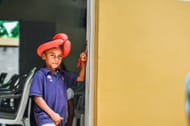Childhood concussions, though relatively frequent, accounting for about five million ER visits and doctor consultations annually, demand serious attention, especially in the case of young children.
With the return of kids to school, sports and playdates, parents are becoming well-acquainted with the usual assortment of scraped knees, runny noses and minor bruises.
Nevertheless, it's vital to remember that bumps and knocks, especially involving the head, should be treated with heightened concern.
Signs of concussion in kids
They're categorized as mild, temporary traumatic brain injuries. Unlike the more severe traumatic brain injuries that involve internal bleeding or visible bruising in the brain and might require hospitalization, concussions necessitate careful handling and observation.
The signs might not surface immediately, sometimes taking several days to manifest. Children who have experienced it, might show signs of forgetfulness, haziness or difficulties concentrating.
Other concerning symptoms that should prompt immediate medical attention include confusion, vomiting, sluggishness, intense headaches or a significant bump at the point of impact.
Is a concussion equivalent to a traumatic brain injury?

It's classified as a mild form of traumatic brain injury. While it doesn't result in internal bleeding or evident bruising in the brain, it's still an injury that requires appropriate care and consideration.
Drawing a parallel between a concussion and a punch to the arm that causes pain but doesn't lead to a bruise can aid in grasping its nature — recovery hinges on rest and healing.
Concussion symptoms in kids
The symptoms of a childhood concussion can be diverse and sometimes subtle. Physical manifestations may include headaches, dizziness, fatigue, nausea and blurred vision.
Additionally, they can exert an impact on a child's emotional state, potentially resulting in symptoms like anxiety, irritability, depression, sleep disturbances or excessive sleepiness.
It's crucial to acknowledge that these symptoms might materialize days after the initial injury, underscoring the importance of vigilant observation. Parents should stay watchful for any unusual behavior in their child, as confusion and disorientation could signify a head injury even after a few days.
Diagnosis
Physicians diagnose it in children based on the symptoms that manifest following a direct blow or jolt to the body. Given that it might not always display immediate symptoms, careful observation and awareness play a pivotal role in identifying the injury.
Managing childhood concussions

In most nstances where severe symptoms don't necessitate medical intervention, the primary approach to treating childhood concussions involves rest and attentive monitoring.
Parents are advised to curtail their child's physical and cognitive activities, like school or sports, for a span of one to three days. A gradual return to routine activities assists in the recuperation process, but any aggravation of symptoms warrants a return to a period of rest.
If a child experiences dizziness or headaches on resuming activities like reading or sports, it serves as a clear indication that a full return isn't yet advisable.
Tailored care for unique recovery paths
It's imperative to comprehend that each experience is individualized for each child. Unlike standardized treatments for infections or illnesses, there isn't a universal approach.
Physicians offer customized care based on a child's specific symptoms, risk factors and baseline cognitive and emotional well-being. Patience is a crucial factor during the recovery process, which can fluctuate in terms of duration and severity.
Parents need to support their child's healing journey by maintaining a vigilant eye and understanding that recovery might be swift or gradual.
As children immerse themselves in various activities and encounter the occasional minor accidents, the potential for concussions remains a concern that parents must address.
Identifying the signs, grasping its nature as mild traumatic brain injuries and offering appropriate care and rest all form integral aspects of ensuring a child's complete and healthy recovery.
Each child's path through it is distinct, and parents must display patience and attentiveness throughout the recuperation process. By staying informed and proactive, parents can effectively guide their children along the road to recovery, allowing them to safely and confidently resume their activities.
